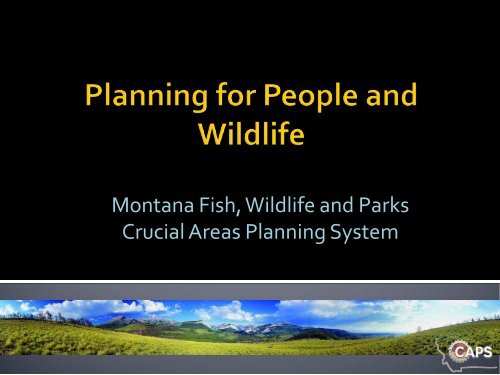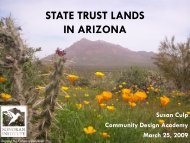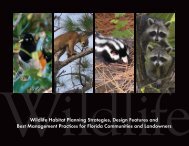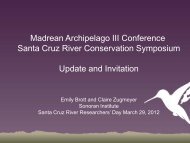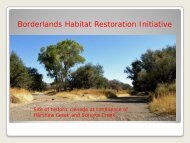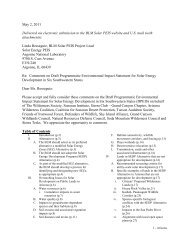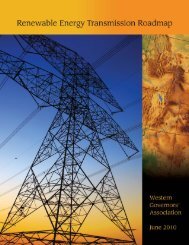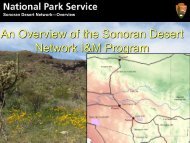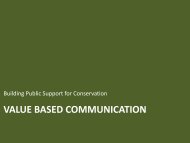Crucial Areas Planning System - Sonoran Institute
Crucial Areas Planning System - Sonoran Institute
Crucial Areas Planning System - Sonoran Institute
- No tags were found...
You also want an ePaper? Increase the reach of your titles
YUMPU automatically turns print PDFs into web optimized ePapers that Google loves.
Montana Fish, Wildlife and Parks<strong>Crucial</strong> <strong>Areas</strong> <strong>Planning</strong> <strong>System</strong>
• Montana Fish, Wildlife & Parks, through itsemployees and citizen commission, providesfor the stewardship of the fish, wildlife,parks, and recreational resources ofMontana, while contributing to the quality oflife for present and future generations.
• A web-based mapping service providingranked fish and wildlife information• Best available data, analyzed andexplained, opportunities to improve• Intended for use during the early planningstages of development projects andassessing conservation opportunities
• Identify the value of Montana’s aquatic andterrestrial resources at an appropriate scale• Modify FWP business process to provide anavenue for the public and our constituentsto gain information early and easier• Increases FWP’s efficiency andtransparency while maintaining FWP staffhaving final consultation
• Implementation Montana’s Comprehensive Fishand Wildlife Conservation Strategy• Not inclusive of terrestrial game and sport fish, FWPlands and other recreational values• Scale not suitable in many cases for project levelplanning• GIS: Consistent and growing demand for spatialinformation• Western Governor’s Initiative - directed at regionalscale identification of "crucial habitat" and"important wildlife corridors”
AquaticTerrestrialHabitatOtherAquaticConnectivityConservationSpeciesWatershedIntegrityDesignatedLandsFish NativeSpeciesRichnessSpeciesRichnessRiparian<strong>Areas</strong>Public LandOwnershipFish Speciesof ConcernGame QualityWetland<strong>Areas</strong>Hunter andAngler ValuedLandsGame FishQualityConnectivityLargeLandscapeBlocksHunterPressure andHarvestStatisticsGame FishLife HistoryAnglerPressure andHarvestStatistics
TerrestrialGame QualityConservationSpeciesSpeciesRichness• Game Quality• 12 species – distribution, habitat value• Conservation Species• 85 species – predicted occurrence• Species Richness• 366 species (breeding and/or year round)-species richness
Big GamePrairie GrouseForest CarnivoresSheep and Goat
Big GamePrairie GrouseForest CarnivoresSheep and Goat
Database shared with BLM -> points fromdatabase mapped -> lek areas defined
Core <strong>Areas</strong>
Prairie GrouseBig Game Winter RangeBlue = 2, Green = 1, White = 0Forest CarnivoreBighorn Sheep and Mt. Goat
• Reduces visual confusion when comparingseparate layers• Broadens and expands number of species andhabitat considered during fish and wildlifereview• Provides FWP analysis• Allows FWP data to be compared with otherdata layers easily
• Govs tasked Wildlife Council to develop state-based,compatible wildlife Decision Support <strong>System</strong>s (DSS)• GIS-based• Publically available• Ensure wildlife information is considered early inplanning and decision-making processes• Compatible across jurisdictions• Promote conservation objectives of each state
8 states developing DSSInvolves datadevelopment, sharing,and tool developmentGoal: create state/levelDSS that can be put intoa regional DSS
http://fwp.mt.govSearch CAPS
• “provides clear information on where FWP would haveconcerns….more importantly, provide information onwhere it may be more appropriate to develop” – EnergyDeveloper• “Allows the conversation to begin on a much higherlevel” – County Planner• “Simple classification gives …a valuable quick summaryof a number of key wildlife factors” –ConservationPlanner• A realtor’s use of CAPS in listing a 6,000 acre ranch tobetter understand the property’s fish and wildlife values
“They say you can’t have your cake and eat it, too. But if CAPS worksas planned, maybe Montanans can have the best of both worlds byfostering healthy economic development in ways that protect thestate’s equally important fish and wildlife resources. “ Joe Maurier,Montana Fish, Wildlife and Parks Director
• Introduce FWP Staff• Teams explore CAPS• Fwp.mt.gov - Search CAPS• Find tutorial on bottom “tray”• Follow exercise provided• Explore CAPS for your project area


